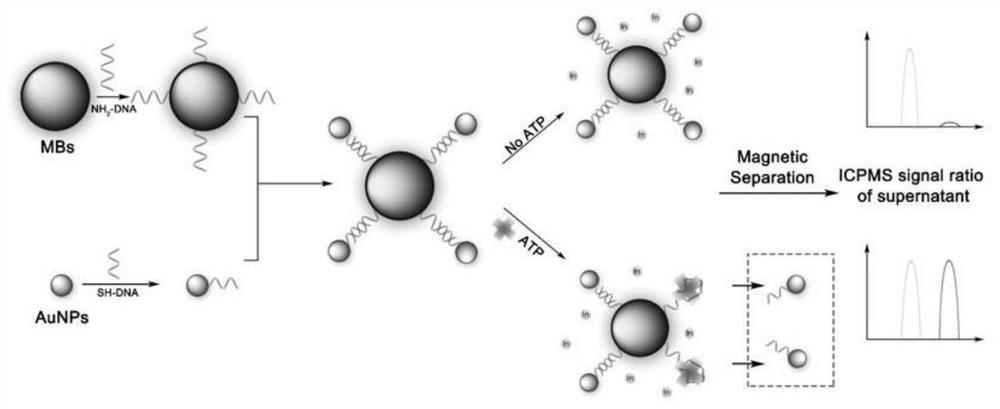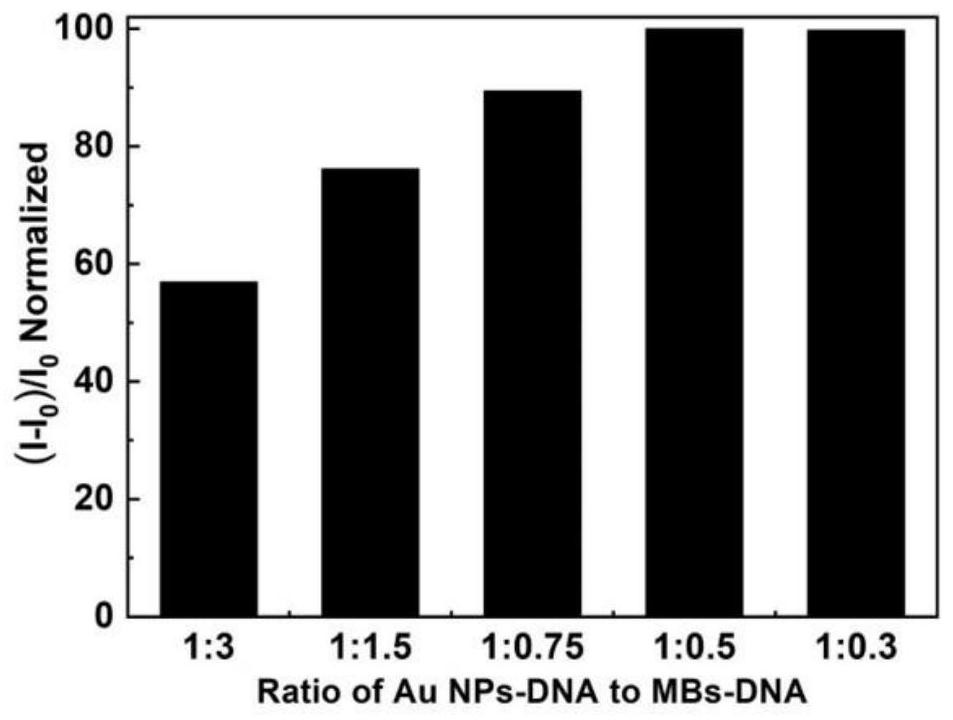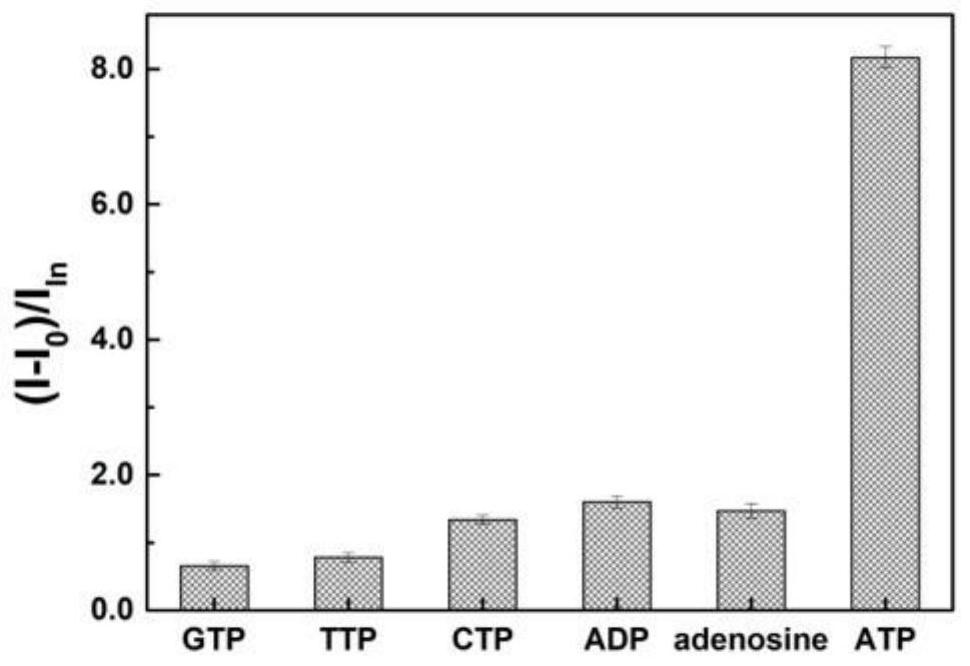An ATP Analysis Method Based on Ratiometric Inorganic Mass Spectrometry Detection
An analysis method and molecular technology, applied in the field of biological and stable isotope sensing, can solve the problems of absolute signal strength fluctuation, absolute strength dependent signal interference, inaccurate detection results, etc., and achieve the effect of simple separation
- Summary
- Abstract
- Description
- Claims
- Application Information
AI Technical Summary
Problems solved by technology
Method used
Image
Examples
Embodiment 1
[0051] S1: Synthesis of gold nanoparticles by the commonly used sodium citrate reduction method;
[0052] S2: Synthesis of DNA1-magnetic bead complexes and DNA2-AuNPs complexes respectively;
[0053] S3: The two complexes were added to the reaction system in different ratios to form a core-satellite structure, and then 7 μL of 10 mM PBS (PH = 7.4, 150 mM NaCl) and 33 μL of 20 mM Tris-HCl (PH = 7.4, 100 mM NaCl) were added ) Mix and shake for a few minutes.
[0054] S4: Add 20 μL of ATP at a certain concentration to the system, and shake for 4 hours;
[0055]S5: Perform magnetic separation on the reacted solution to obtain a supernatant, which is reacted with 50 μL aqua regia for 20 minutes, and then dissolved by 1.5 ng ml -1 Dilute the standard In solution to 4mL.
[0056] S6: Recording by ICPMS of the 197 Au and 115 In signal intensity and calculate its ratio.
[0057] Experimental results:
[0058] This experiment is to explore the effect of the ratio of the two compl...
Embodiment 2
[0063] S1: Synthesis of gold nanoparticles by the commonly used sodium citrate reduction method;
[0064] S2: Synthesis of DNA1-magnetic bead complexes and DNA2-AuNPs complexes respectively;
[0065] S3: 3 μL DNA1-magnetic bead complex and 6 μL DNA2-AuNPs complex were added to the reaction system to form a core-satellite structure, and then 7 μL 10 mM PBS (PH = 7.4, 150 mM NaCl) and 33 μL 20 mM Tris-HCl (PH = 7.4, 100mM NaCl) Mix and shake for a few minutes.
[0066] S4: Add ATP or other interfering substances to the system, shake and react for 4 hours;
[0067] S5: Perform magnetic separation on the reacted solution to obtain a supernatant, which is reacted with 50 μL aqua regia for 20 minutes, and then dissolved by 1.5 ng ml -1 Dilute the standard In solution to 4mL.
[0068] S6: Recording by ICPMS of the 197 Au and 115 In signal intensity and calculate its ratio.
[0069] Experimental results:
[0070] This experiment is a study on the ATP selectivity of the analytic...
Embodiment 3
[0075] S1: Synthesis of gold nanoparticles by the commonly used sodium citrate reduction method;
[0076] S2: Synthesis of DNA1-magnetic bead complexes and DNA2-AuNPs complexes respectively;
[0077] S3: 3 μL DNA1-magnetic bead complex and 6 μL DNA2-AuNPs complex were added to the reaction system to form a core-satellite structure, and then 7 μL 10 mM PBS (PH = 7.4, 150 mM NaCl) and 33 μL 20 mM Tris-HCl (PH = 7.4, 100mM NaCl) Mix and shake for a few minutes.
[0078] S4: Add different amounts of ATP to the system, shake and react for 4 hours;
[0079] S5: Perform magnetic separation on the reacted solution to obtain a supernatant, which is reacted with 50 μL aqua regia for 20 minutes, and then dissolved by 1.5 ng ml -1 Dilute the standard In solution to 4mL.
[0080] S6: Recording by ICPMS of the 197 Au and 115 In signal intensity and calculate its ratio.
[0081] Experimental results:
[0082] This experiment is to study the analytical performance of the present invent...
PUM
 Login to View More
Login to View More Abstract
Description
Claims
Application Information
 Login to View More
Login to View More - R&D
- Intellectual Property
- Life Sciences
- Materials
- Tech Scout
- Unparalleled Data Quality
- Higher Quality Content
- 60% Fewer Hallucinations
Browse by: Latest US Patents, China's latest patents, Technical Efficacy Thesaurus, Application Domain, Technology Topic, Popular Technical Reports.
© 2025 PatSnap. All rights reserved.Legal|Privacy policy|Modern Slavery Act Transparency Statement|Sitemap|About US| Contact US: help@patsnap.com



